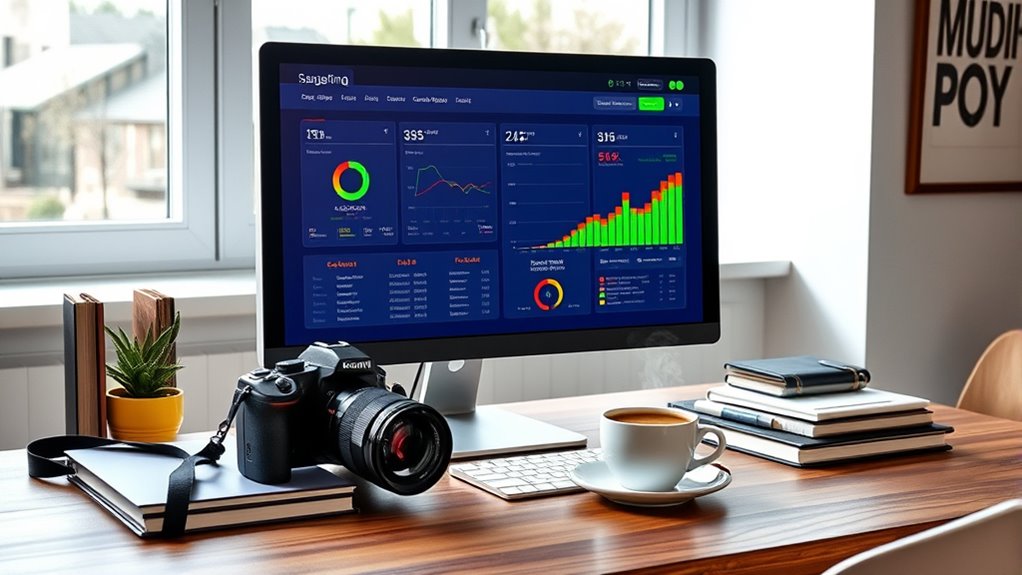From day one, you should focus on key email KPIs like open rate, click-through rate, bounce rate, unsubscribe rate, and conversion rate. These measurements reveal how well your emails engage your audience and deliver results. Additionally, tracking list growth and spam complaints helps maintain your sender reputation. Keeping an eye on these metrics guarantees you optimize your campaigns effectively; continue exploring to see how each one impacts your success.
Key Takeaways
- Track open rates to measure how many recipients view your emails and optimize subject lines accordingly.
- Monitor click-through rates to assess engagement with your email content and improve calls-to-action.
- Regularly check bounce rates to maintain list health and ensure message delivery.
- Observe unsubscribe rates to identify content or frequency issues and retain your audience.
- Measure conversion rates to evaluate how effectively emails turn recipients into customers or leads.
Open Rate

Have you ever wondered how many of your email recipients actually open your messages? Open rate is a key metric that reveals this. To improve it, focus on personalization tactics—using recipients’ names or tailored content makes your email more inviting. Subject line optimization is equally essential; craft clear, compelling, and relevant subject lines that pique curiosity or offer value. Avoid generic or spammy phrases, which can decrease open rates. Think about what your audience cares about and reflect that in your subject lines. Additionally, testing different approaches helps identify what resonates best. By combining personalization tactics with effective subject line optimization, you’ll increase your chances of grabbing attention right from the inbox, ensuring more recipients open and engage with your emails. Understanding email marketing KPIs can further guide your strategy and improve overall performance.
Click-Through Rate (CTR)

Wondering how many of your email recipients actually click on your links? Your click-through rate (CTR) reveals this. A strong CTR indicates that your subject line caught their attention and your email design encouraged engagement. If your CTR is low, consider testing different subject lines to boost curiosity or relevance. Also, review your email design—clear calls-to-action, mobile-friendly layout, and concise content make it easier for readers to act. Tracking CTR from the start helps you understand which elements drive clicks and refine your strategy. Remember, a high CTR means your message resonates, and your links are compelling enough to prompt action. Keep optimizing your subject line and email design based on this KPI to improve overall campaign performance. Additionally, analyzing your content strategy can help identify what type of messages generate more clicks and engagement.
Bounce Rate

While a high click-through rate shows your email content is engaging, understanding bounce rate helps guarantee your messages actually reach your audience. Bounce rate measures the percentage of emails that don’t make it to your recipients’ inboxes. A high bounce rate can indicate issues like invalid email addresses or overly aggressive email frequency, which may lead to deliverability problems. To reduce bounces, ensure your email list is clean and updated regularly. Personalizing your content can also improve engagement, decreasing the likelihood of your emails bouncing because recipients are more likely to open and interact with relevant messages. Monitoring bounce rate allows you to identify technical issues early and refine your email strategy, ensuring your campaigns effectively reach your audience and maximize your marketing efforts. Additionally, maintaining a healthy email list is crucial for sustaining low bounce rates and achieving consistent campaign success.
Unsubscribe Rate

Understanding your unsubscribe rate is essential because it directly reflects how your audience perceives your emails. If your unsubscribe motivations stem from irrelevant content, too many emails, or poor timing, you’ll see higher rates. Pay attention to unsubscribe timing—if people leave right after certain campaigns or at specific times, it signals issues with your messaging or frequency. By tracking this KPI, you can identify patterns and adjust your email strategy accordingly. Keep your content targeted and valuable, and avoid overwhelming your subscribers. When you understand what causes unsubscribes, you can optimize your campaigns to improve engagement and retention. Additionally, analyzing your email content quality helps identify whether your messaging aligns with your audience’s interests. Ultimately, managing your unsubscribe rate helps ensure your emails remain welcome in your audience’s inboxes, boosting your overall email marketing success.
Conversion Rate

Your conversion rate shows how well your emails turn recipients into customers, but it’s influenced by open rate insights and engagement duration. If your open rates are high but conversions are low, it might mean your content isn’t compelling enough or engagement isn’t sustained. Tracking these points helps you optimize your emails for better results. Additionally, understanding email marketing ethics can help you build trust with your audience, improving overall engagement and conversion.
Open Rate Insights
Have you ever wondered how effectively your emails turn opens into meaningful engagement? Your open rate is a vital indicator of your email’s initial impact. To improve it, focus on subject line optimization—craft compelling, relevant, and curiosity-provoking headlines that grab attention instantly. Additionally, refine your send time strategies by analyzing when your audience is most active. Sending emails at prime times increases the chances of your message being opened promptly. Remember, a strong open rate sets the foundation for higher click-through and conversion rates. Keep testing different subject lines and send times to discover what resonates best with your audience. By fine-tuning these elements, you’ll boost your open rate and set the stage for meaningful engagement from your email campaigns.
Engagement Duration
Engagement duration, or conversion rate, measures how long recipients stay engaged with your email content before taking the desired action. To improve this, focus on subject line enhancement to grab attention quickly and perform send time analysis to reach audiences when they’re most responsive. Longer engagement indicates your content resonates and encourages action. Additionally, understanding aura can help tailor messaging that connects more deeply with your audience’s emotional states.
List Growth Rate

Tracking your list growth rate is essential because it shows how effectively your email campaigns attract new subscribers. A steady increase indicates your segmentation strategies and personalization tactics are resonating with your audience. To improve this metric, examine which segments respond best to your campaigns and tailor your messaging accordingly. Regularly monitor how many new contacts you add over time and identify patterns that lead to higher sign-up rates. If growth stalls, refine your lead magnets or optimize your signup forms. Remember, a healthy list growth rate isn’t just about numbers but also about attracting engaged subscribers who find value in your emails. Additionally, understanding how your list segmentation impacts subscriber acquisition can help you tailor your outreach more effectively. Regularly tracking this KPI helps you adjust your strategies early, ensuring sustained audience expansion.
Spam Complaint Rate

Why does the spam complaint rate matter so much for your email marketing? Because a high spam complaint rate can damage your sender reputation, making it harder for your emails to reach inboxes. When recipients mark your messages as spam, email providers view this as a sign that your content isn’t relevant or trustworthy. A poor sender reputation can lead to increased filtering and lower open rates, ultimately hurting your campaign’s success. Monitoring your spam complaint rate helps you identify issues early, such as misleading subject lines or irrelevant content. Keeping this rate low ensures your emails stay out of spam folders and maintains your credibility with inbox providers. Remember, a good sender reputation is key to long-term email marketing effectiveness.
Frequently Asked Questions
How Often Should I Review My Email KPIS?
You should review your email KPIs at least weekly to stay on top of performance. Regular checks help you assess the effectiveness of your email segmentation and personalization efforts. By analyzing open rates, click-through rates, and conversions, you’ll identify what’s working and what needs improvement. Adjust your strategy accordingly, ensuring your emails resonate with your audience and drive engagement. Consistent reviews keep your campaigns targeted and successful over time.
Which Email KPI Is Most Important for New Marketers?
Think of your email campaign as a conversation—what’s the most important thing you want your audience to say? For new marketers, open rate is king because it shows how well your segmentation strategies and personalization techniques capture attention. By focusing on open rates, you understand if your subject lines and targeting hit the mark first, setting the stage for deeper engagement and overall success.
How Can I Improve My Email Open Rates?
To improve your email open rates, start by focusing on email segmentation to target the right audience with relevant content. Experiment with subject line testing to find phrases that resonate and entice recipients to open. Personalize your emails based on subscriber behavior and preferences, and continually analyze your metrics. These strategies help boost engagement and open rates, making your campaigns more effective from the very beginning.
What Is a Healthy Bounce Rate for Emails?
Ever wondered what a healthy bounce rate is? It’s vital for your email deliverability and bounce rate analysis. A good bounce rate typically stays under 2%, meaning most emails reach your audience. Anything higher signals issues with your list quality or technical problems. Keep an eye on this metric, and you’ll improve your campaigns’ effectiveness, ensuring your messages land in inboxes rather than spam folders.
How Do I Interpret Low Click-Through Rates?
When you see a low click-through rate, it suggests your email’s subject line or call to action might not be compelling enough. You should analyze whether your subject line grabs attention and if your call to action clearly tells recipients what to do next. Testing different subject lines and call to action buttons can help improve engagement. Remember, tweaking these elements can markedly boost your click-through rates over time.
Conclusion
By tracking these KPIs, you paint a clear picture of your email’s health, guiding your strategy like a compass pointing north. Monitoring open rates, click-throughs, bounces, unsubscribes, conversions, list growth, and spam complaints keeps you aware, alert, and agile. When you understand each metric, you build trust, boost engagement, and refine your approach. Stay attentive to these signs, and watch your email marketing thrive like a well-tuned machine, always moving forward, always improving.









